Samsung UE65JS9500 Review
Samsung UE65JS9500
The 4K HDR future of TV is here. And it's stunning
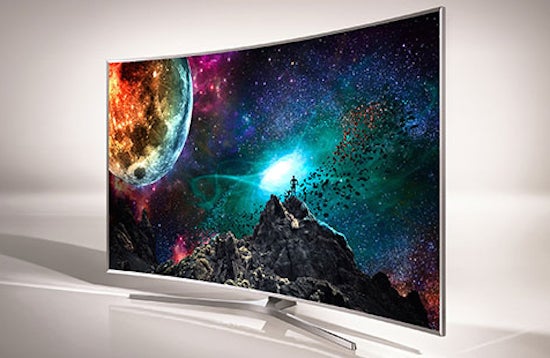
Sections
- Page 1 Samsung UE65JS9500 Review
- Page 2 Picture Quality Review
- Page 3 3D, Sound and Verdict Review
Verdict
Pros
- Incredible HDR picture quality
- Tizen OS is slick and helpful
- Upgradable connectivity and processors
Cons
- It's not cheap
- Native UHD and especially HDR content in short supply
- The curve won't suit everyone
Key Specifications
- Review Price: £5999.99
- 65-inch LCD TV with direct LED lighting and local dimming
- Native UHD/4K resolution
- High Dynamic Range playback
- Nanocrystal (Quantum Dot) colour technology
- Tizen-based Smart TV engine
What is the Samsung UE65JS9500?
It’s become pretty much
customary now for Samsung to try and set the TV pace every year by being
first to market with its new flagship TV. And the Korean company has
thrown everything at the 65-inch Super UHD UE65JS9500 – it has HDR (high dynamic range) playback, native 4K/UHD resolution, a Nanocrystal colour system, a curved screen and the new Tizen Smart TV system.
The
pace it sets is so extreme that we’re hearing reports of grown cheetahs
crying. Let’s see if it ends up a winner or if it outpaces itself…
SEE ALSO: What is 4K/UHD?
Samsung UE65JS9500 – Design and Features
Aesthetically
the UE65JS9500 is a bold move in a number of ways. Particularly
striking is the way it consciously bucks the trend for ultra-thinness.
The rear is the chunkiest we’ve seen from a premium Samsung TV in years,
with its central portion even approaching the depth of last year’s
hefty Sony wedge TVs.
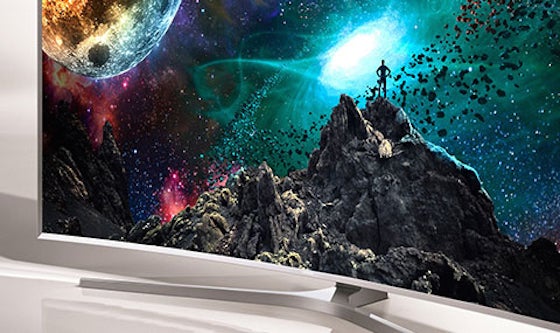
You
don’t notice this depth when you’re watching from the front, though, so
while the chamfered metallic bezel is also slightly wider than those
wrapped around many of today’s screens, you certainly can’t accuse of it
taking over an unreasonable amount of your living room.
The
bezel is keener than most modern examples to make its presence felt,
though. As well as boasting that gleaming metallic finish, it stands
some distance proud of the screen at its edges and angles back towards
the display. This creates quite a severe, angular effect in stark
contrast to both the gentle curvature of the screen and the boomerang
shape of the physics-defying silver stand.
TrustedReviews Awards 2015: Winners announced
The main issue with
the design is that the angled bezel can distractingly catch any strong
light sources in your room – especially if you have ceiling lights.
Plus, of course, some people will not like the fact that the
UE65JS9500’s screen is curved…
We’re not going to get into all the pros and cons of curved screens here, as we’ve done it all before in a separate feature.
But you should know that if you want the highest level of picture
performance from a Samsung TV this year, you’ll need to get the
UE65JS9500, curves and all. There’s not going to be a flat equivalent.
Though if it helps we can say right away that one of the biggest
problems with curved TVs – distorted onscreen reflections – is certainly
greatly reduced on the 65JS9500 versus last year’s models. More on
this later.
After what felt like a relatively small evolution
with its 2014 TV range, Samsung has pulled out all the feature stops for
the JS9500 series – also available in 78-inch and 88-inch sizes – to
deliver a genuinely huge leap forward.
The undoubted star of the
show is its high dynamic range capability, which is a way of filming and
then showing content that delivers a much wider luminance range, with
brighter whites, deeper blacks, and a far more extensive greyscale and
colour range in between.
Demos of HDR have consistently looked
remarkable, so even though there’s still a debate over the best industry
standard for HDR in the living room, we’re hugely excited to be able to
experience it already on the first TV of 2015. It’s interesting to
note, too, that while other brands are hinting at HDR compatibility with
their 2015 flagship TVs, no other brand has formally confirmed it – at
least not for any models with a fairly imminent launch date. So it could
be that Samsung opens up quite a lead over its rivals in HDR terms.
SEE ALSO: What is HDR TV?
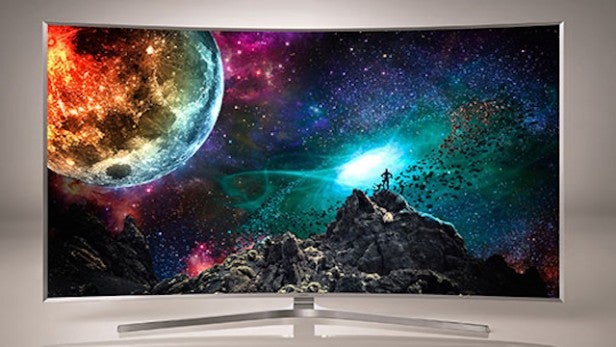
To
deliver on its HDR promise, the UE65JS9500 claims a huge native
brightness output of 1000 nits – versus a typical 300-500 nits – and
claims to be able to deliver up to 93 per cent of the Digital Cinema
Initiative (DCI) colour range you see at commercial cinemas.
How
has Samsung achieved this? First it’s developed a new proprietary
nanocrystal take on Quantum Dot colour technology. Second, it’s
developed a new 10-bit – versus the normal 8-bit – panel with high light
transmittance capabilities. Third, it’s employed a new type of light
source, which in the JS9500’s case is positioned directly behind the
screen and driven by local dimming for enhanced contrast. And finally
it’s developed a new processing engine focused on optimising the new
Quantum colour engine, better controlling the lights and darks in the
HDR image range, and being cleverer about recognising and then
accurately dealing with different types of picture content.
It
also, of course, has the processing knowhow to both recognise HDR
content when it’s fed in, and potentially “scale” that HDR to fit its
screen’s parameters and capabilities. Arguably even more importantly,
given that HDR content is currently non-existent to consumers, is that
the UE65JS9500 has the processing power to upgrade non-HDR content to
fit with the expanded brightness and colour range its panel can deliver.
This is potentially as controversial as it is intriguing, with a
certain type of videophile likely arguing that they want to see things
that look faithful to the format they were created in – usually the Rec
709 image standard – rather than material that’s gone through some sort
of “expansion processing”. But fear not; if that sounds like you,
there’s a setting on the TV that lets you see images accurate to the Rec
709 standard. Our experience, though, has been that once you’ve seen
anything “HDR’d”, going back to a standard that was developed for CRTs
decades ago feels almost painful.
Returning briefly to the
current lack of native HDR content, there is some good news in that
Netflix is now mastering most, if not all, of its home-grown shows in
HDR, and intends to start streaming them this year. Samsung is in
discussions with Netflix to nail down the specifics of how this HDR
streaming will happen, but it assures us that the 65JS9500 will be
able to handle the HDR streams when they go live.
We also wouldn’t be surprised if Samsung launched some sort of HDR Video Pack, like the UHD Video Pack
launched for its 4K TVs last year – especially as it’s already able to
provide HDR showcase reels for The Life Of Pi and Exodus.
Inevitably
the UE65JS95000 sports a native UHD (aka 4K) pixel count of 3840 x
2160, to deliver four times HD levels of detail. And Samsung claims to
have improved the quality of its 4K upscaling engine from last year’s
already high level.
SEE ALSO: What are quantum dots?
As
for the curved screen, it features seemingly the same degree of
curvature that Samsung was using last year, though the brand claims to
have enhanced the depth enhancement processing it applies to images to
make them more suited to a curved environment.
This processing,
too, could be a source of controversy, given that you can’t turn it off.
But at least Samsung has genuinely improved the way it works, as we’ll
cover later.
Yet another key feature of the UE65JS9500 is its new
powered-by-Tizen Smart TV engine. As usual we’ll be covering this in
depth in a separate article, but here’s a flavour of it to keep you
going until then.
Powered, along with the video processing, by a
new Octa Core brain, the new Smart engine represents a substantial shift
from last year’s content-rich but long-winded and sometimes confusing
system, delivering a much more friendly, stripped down and useful
experience. Most of the Smart menus are now overlaid on a relatively
small part of the image, so they don’t disrupt your viewing, and they’re
much more focused on getting you faster to the content you want. A huge
part of this involves treating everything – including individual TV
channels and each input – as its own app, so that they can populate a
Recently Watched list that pops up as soon as you hit the Smart TV
button.
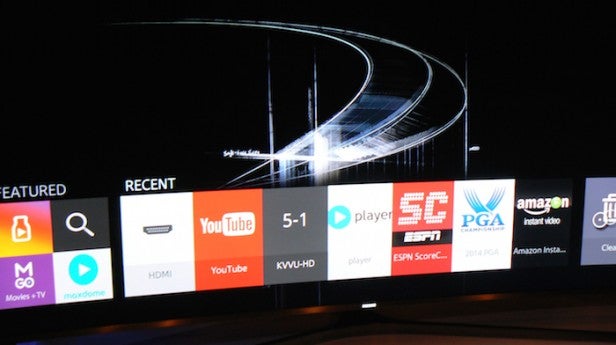
It’s all pretty reminiscent of the LG webOS
system, to be honest, but this is no bad thing. And Samsung has
introduced a few neat ideas of its own, including icons that crop up in
the centre of each side of the screen when using gesture control or the
remote’s point-and-click function as shortcuts to volume control, setup
menu access, Smart menu access and channel shifting/EPG access.
One
final thing worth stressing about Tizen – indeed, arguably its biggest
selling point – is the way it claims to hugely simplify integration with
your Smart devices, to the point where if you have a Samsung phone from
the S4/Note 3 onwards the TV will detect that phone’s presence as soon
as it enters the room, and automatically establish communications with
it. The feature wasn’t ready in time for this review, but it’s safe to
say that when it’s working, removing the usual manual labour from such
connectivity will make it much more likely that you’ll engage with
second-screen features such as video sharing between devices.
The
last key feature of the UE65JS9500 we need to cover is its
connectivity. As with the past couple of generations of Samsung’s
high-end TVs, the 65JS9500 ships with an external One Connect device
containing all of its sockets. These include four USB ports and four
HDMIs, but the most important point about using an external connections
box – which also houses the TV’s brains – is that it can be replaced
with an updated model as new chipsets and even, potentially, new
connections become available. 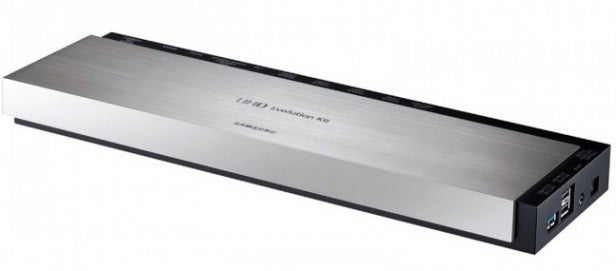
This
is a potentially very significant feature. After all, we’ve already
seen a recent shift from HDMI 1.4 to HDMI 2.0 to support UHD at 50/60Hz,
and there’s plenty of talk of a second wave of UHD quality requiring
yet another connection upgrade in the next two to three years. So
offering an easily upgradable connections system is a great future proof
touch that we’re frankly surprised other brands haven’t started to
copy.
Samsung UE65JS9500 – Setup
First, some really great
news: the 65JS9500 is much more forgiving in picture setup terms than
previous Samsung TVs. In fact, while once again we find ourselves
wishing Samsung would include more preset options than four – plus a
hidden game one – the Standard preset is now pretty usable without you
having to make wholesale changes to it.
That said, there are a
few settings we’d suggest you invest time in to really optimise things.
First, turn off all noise reduction systems for UHD, and arguably even
HD, sources. Drop the contrast level to between 85 and 90 from the 100
preset level. Set the Dynamic Contrast to Medium or even, at a push,
High – the new panel design supports and even relishes this in a way the
previous generation of panels never could. Leave the Black Tone feature
off – you just don’t need it, and it can suppress shadow detail – and
make sure you track down the Game preset in the General submenu of the
Systems menu when gaming.
Finally we’d recommend that you set up a
custom mode for the Auto Motion Plus processing that sets the Blur and
Judder reduction elements to around 4 each.
Even if you do
precisely none of these changes, though, the UE65JS9500’s pictures will
instantly have your mouth hanging open in awe. Especially if you’ve
managed to secure some native HDR content.
How we test televisions
We test every TV we review thoroughly over an extended period of time. We use industry standard tests to compare features properly. We’ll always tell you what we find. We never, ever, accept money to review a product.

